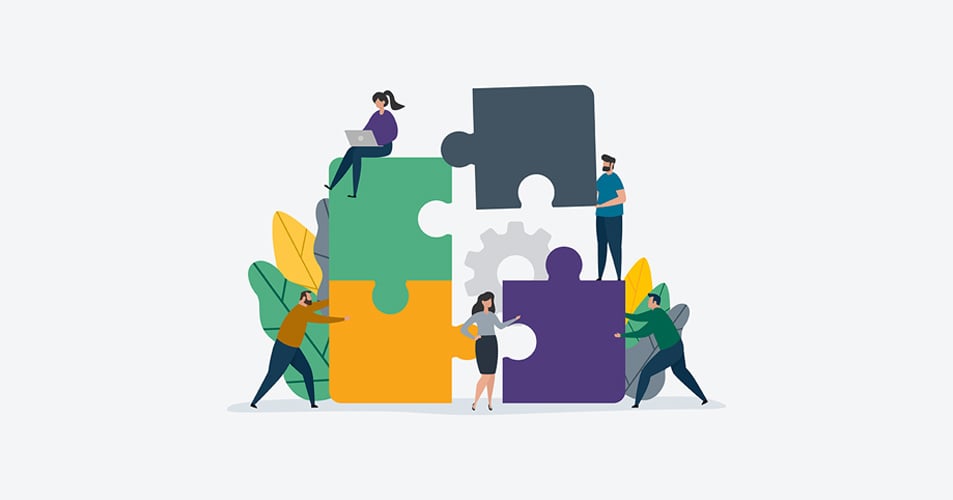
A great way to start soft skills programs is with a simple question: What is more challenging? Is it building alignment with external stakeholders (such as customers, suppliers, healthcare professionals) or building alignment with internal stakeholders (like leadership, learners, team members)?
About 70% of participants share that it is more difficult to gain agreement from their internal stakeholders.
Typically, we interact with a wide variety of internal colleagues to advance our work. We may collaborate across functions, levels of seniority, and geographies, and each person brings their own goals and working styles. Too often we feel both stuck in the middle among many stakeholders with competing interests, and unable to make meaningful progress.
How can we build alignment, more effectively coalescing around a shared vision of success and delivering excellent work collaboratively?
A Problem-Solving Approach
Often, delivering excellent work is not the hard part — it is getting agreement on what work to do (timeline, format, and so forth) across a range of stakeholders. The hard part is building broad alignment — the art of the internal deal. Because you must strengthen your internal relationships without sacrificing substance, try a joint-problem-solving approach.
Here are five tips you can consider to more effectively build alignment among your colleagues:
1. Reframe the "Golden Rule"
"Treat others the way you want to be treated" is not bad advice, but it is not optimal when we are working with people who are different from ourselves. Go beyond the so-called "golden rule" and treat other people the way they want to be treated. The way that we engage others matters immensely, particularly in a matrixed environment where you may interact with colleagues who have a broad range of working styles and responsibilities.
Take a step back and reflect — what does each stakeholder care most about? And how do they like to engage? (Email, videoconference, phone, Slack, in person, etc.) If you don't know the answers to these questions, ask!
Mind-reading capabilities have not yet been developed. And even if they had, people appreciate when you make the effort to better understand how you can best work together. Maintain a short list of "care abouts" (priorities) and communication preferences for your key stakeholders, even if mentally, and use that to guide your engagement through the following steps.
2. Focus on Objectives
Taking your colleague's "care abouts" into account, consider the ways in which your objectives are shared. Also note where others may have additional objectives that differ from your own. When you approach internal colleagues, ensure that you state the objectives you are hoping to meet in a way that captures your qoals as well as theirs. This will drive alignment by ensuring that you are working with a shared definition of success and will focus your collaborative efforts on a discrete set of challenges.
As you sort among possible solutions, consider which best meet your goals... and your colleagues'. Note tradeoffs among different options and areas where you would like to seek further input. If there are certain tasks you need support to complete, flag those as areas requiring further input as you work through the next steps.
3. Harness the Power of Narrative
As you prepare to share proposals (whether informally or formally), consider how to best lay out the information you want to share. Think again about your counterpart's priorities and preferences; what information will be most important and compelling to them? Ensure that it is included each step of the way. Then, frame a quick narrative describing how you will meet your objectives.
- Start with the basis for your thinking. In brief, what examples, standards or information did you start with? "Looking at our competency framework and the feedback the team received last cycle..."
- Then share a quick overview of your thought process. What did you focus on and why? Did you make any assumptions? "I noticed that there is a gap in territory management skills. I think this might be partially due to the recent growth of our portfolio. As you know, our team is spread thin and trying to bring on new customers. They have not had much time to organize their thinking. Our top performers have the right instincts, but I think the broader team would benefit from some support."
- Lastly, share your conclusion. "Based on this, I propose..." "I think it might be helpful to set some time aside with the team to introduce a few territory management principles, begin to apply them in a workshop setting, and then set up some 1:1 coaching to pull through the learning and track the impact."
After you have shared your picture of a possible way forward, it is time to get input.
4. Embrace Being Wrong About the Right Solution
Follow up your proposal with, "What have I missed? Do you see anything differently?"
Our automatic reaction after sharing something is to defend our position, but that is counter to building agreement. Defensiveness deters potential supporters and diminishes the value of gathering broad input. Remain genuinely open to others' feedback. Focus on asking clarifying questions ("What do you mean by... ") and confirming your understanding ("What I hear you saying is... did I get that right?").
While knowing that you cannot deliver every person everything they want, you can remain open to other perspectives and ideas. This will ultimately help to build support and improve your solution by making multi-stakeholder alignment a strength rather than a liability.
As you coalesce around a solution, be sure to repeat the communication process described above with the added step of acknowledging what new information you considered, how your thought process evolved, and highlighting how your proposal was improved based on the feedback you received. Again, be open to and actively gather feedback.
5. Be Consistent!
Consistent consideration of others' "care abouts," consistent alignment around objectives and consistent engagement (including a balance of explaining how you see it, soliciting input, and checking understanding) will build trust, improve efficiency, and lead to less painful internal collaborations. Working on these skills is a conscious effort, and even those of us who teach these concepts sometimes falter. (Whoever decided to call them "soft skills" forgot that they are quite hard to learn as adults...)
When the going gets tough, take a deep breath and do your best to remember that you are all working toward a shared goal — improving patients' lives (even if indirectly). Then, start at Step 1.
Originally published in LTEN's Focus on Training magazine.
.png?width=512&height=130&name=vantage-logo(2).png)

